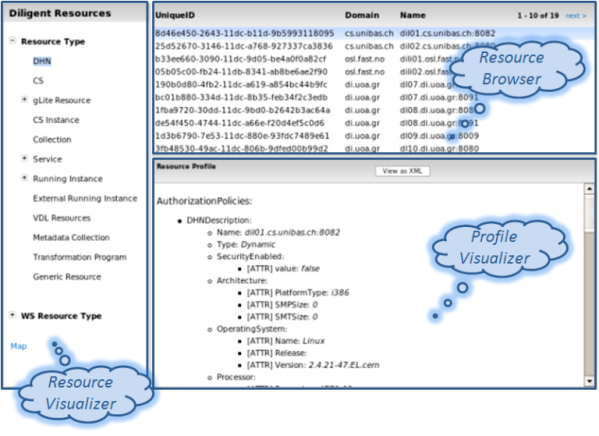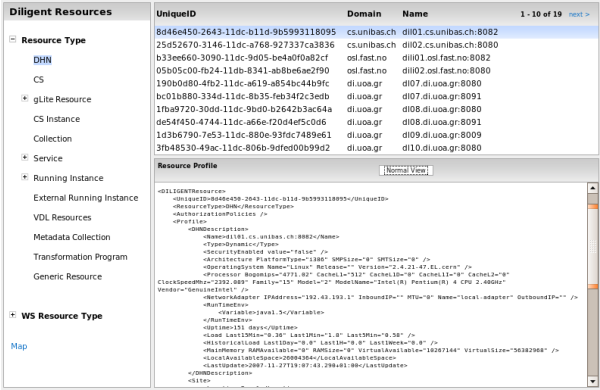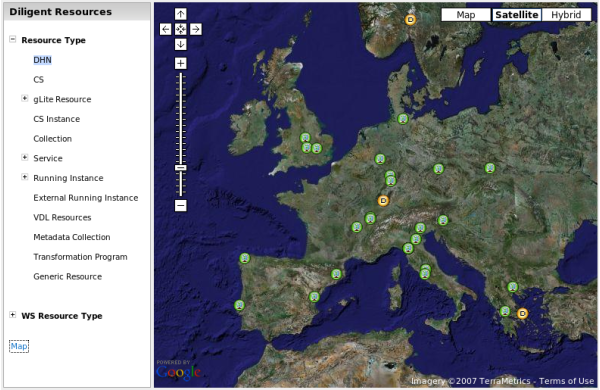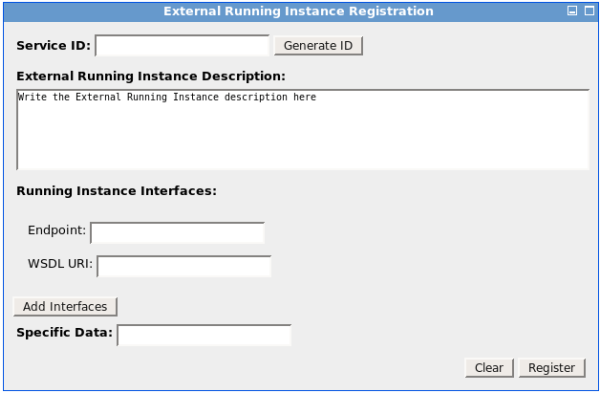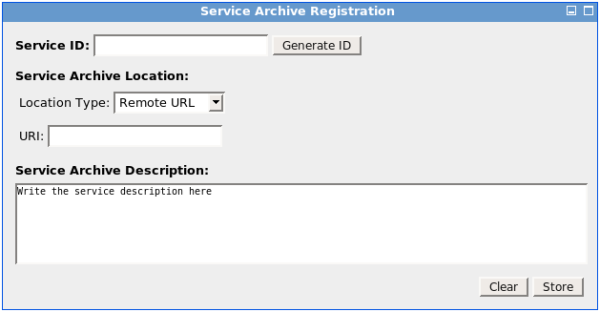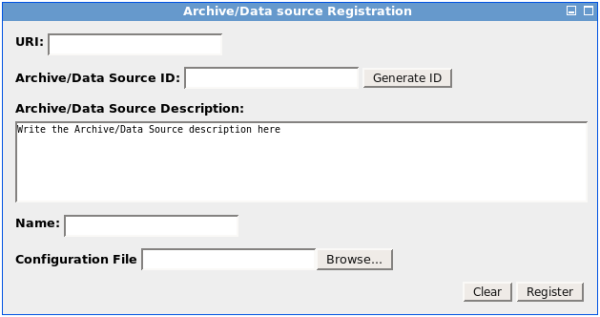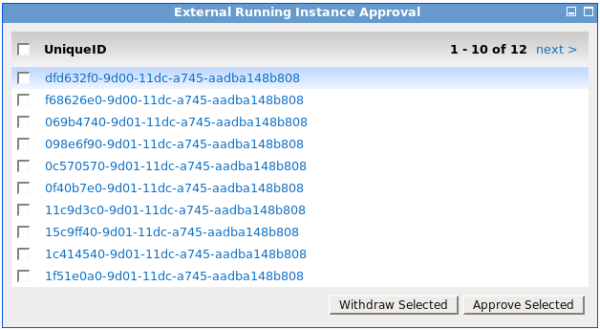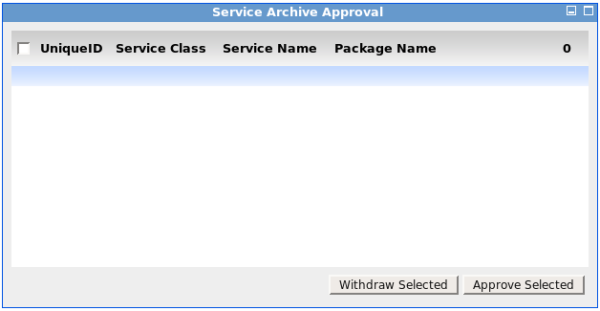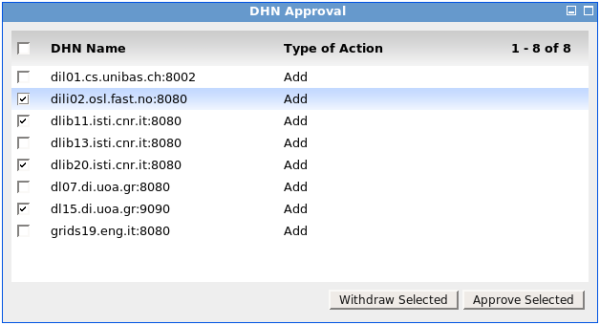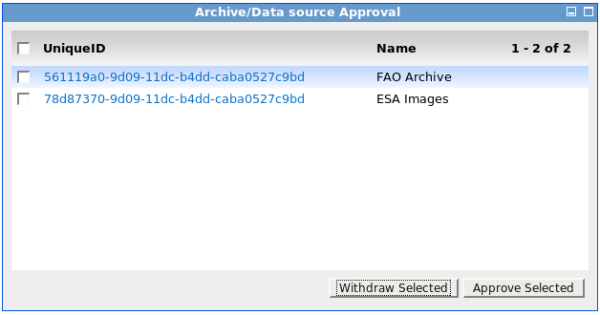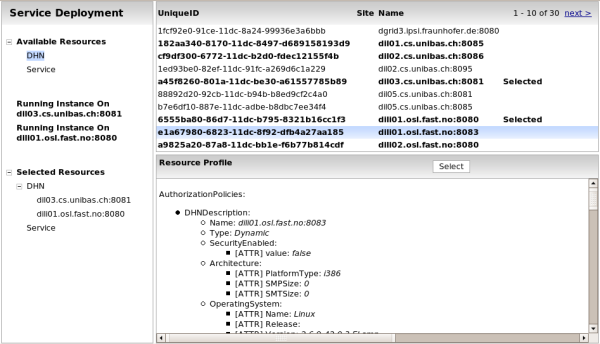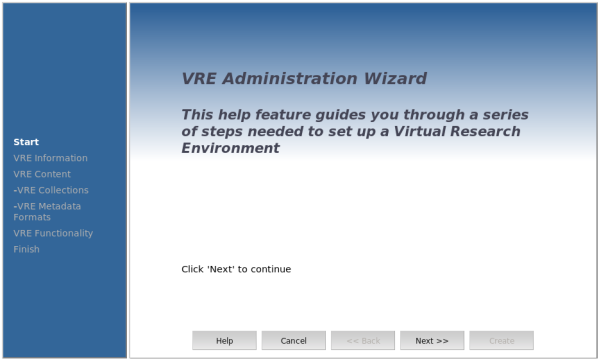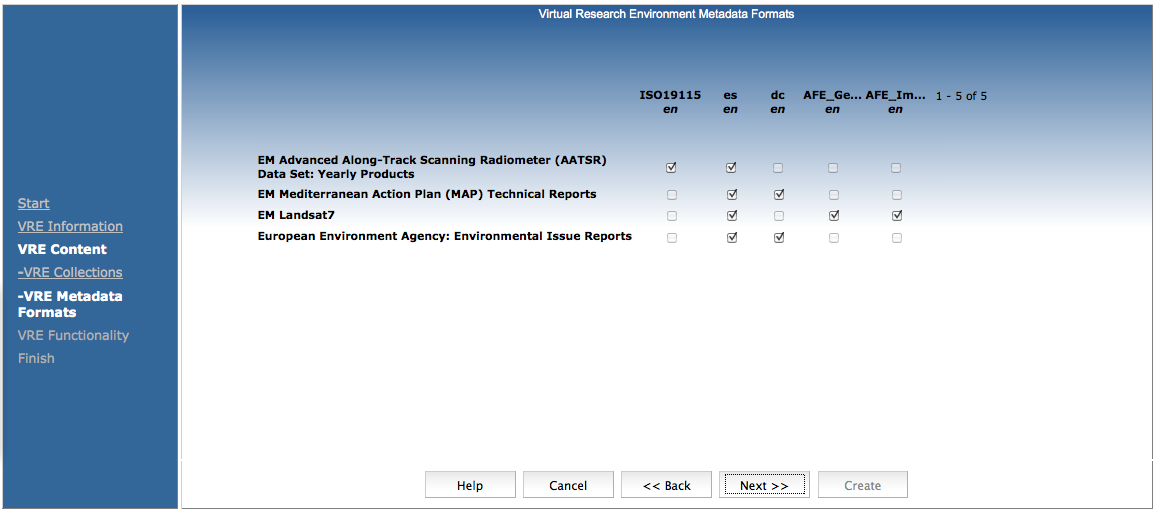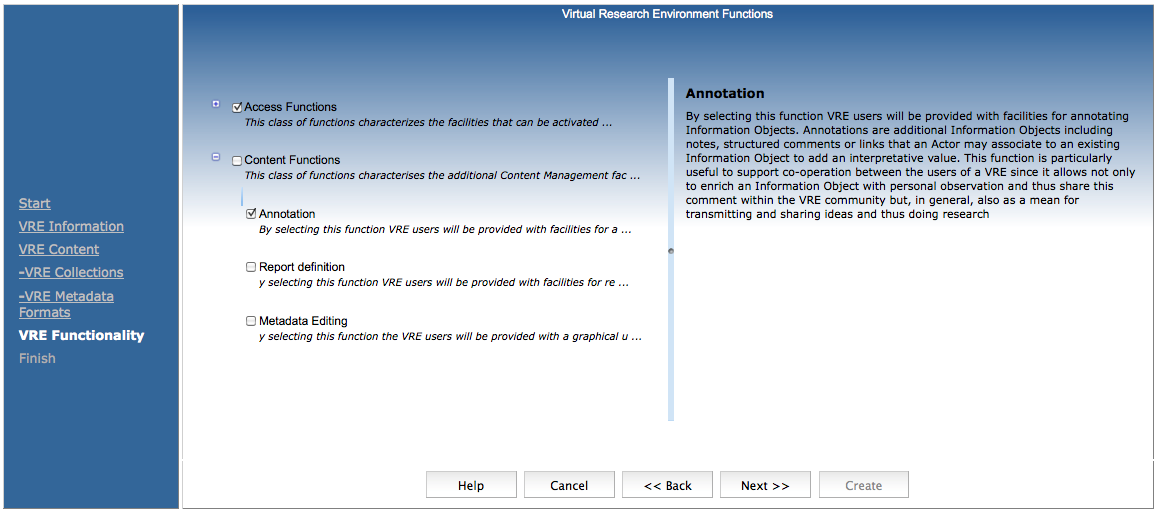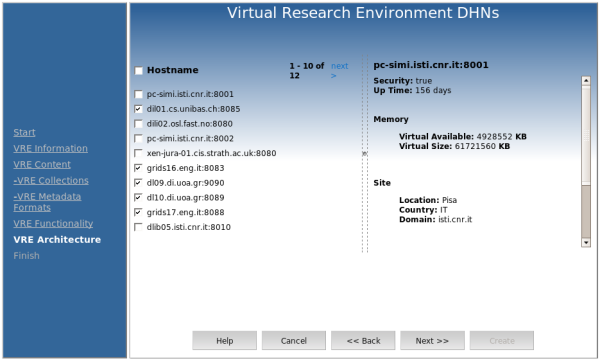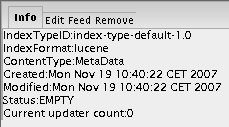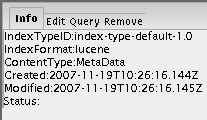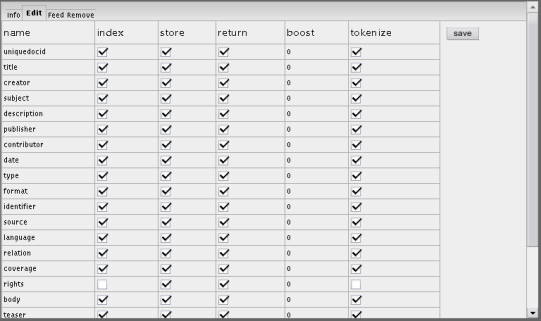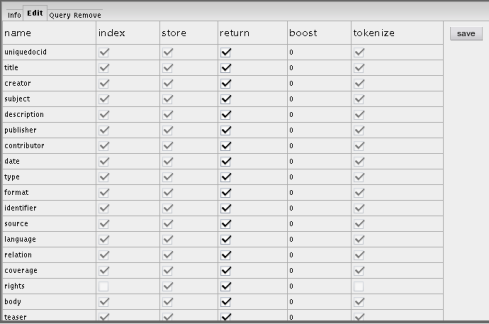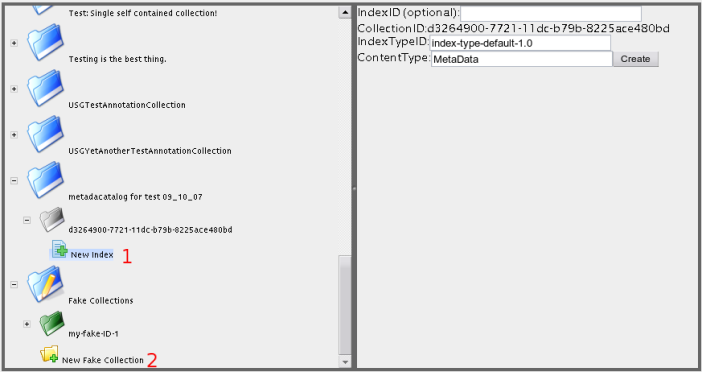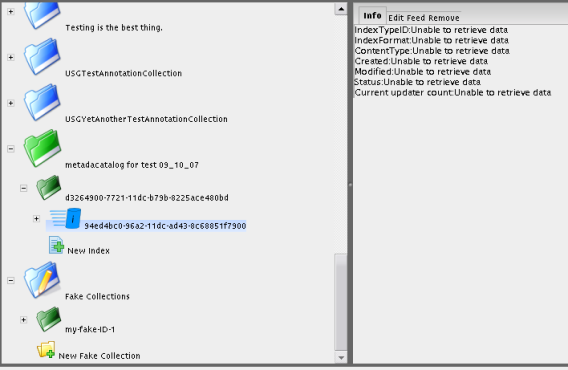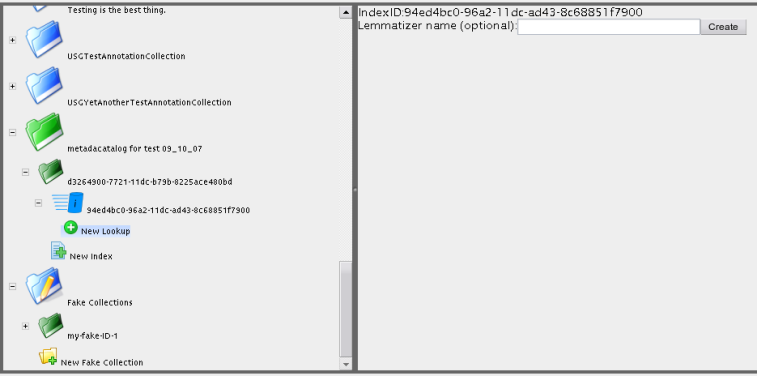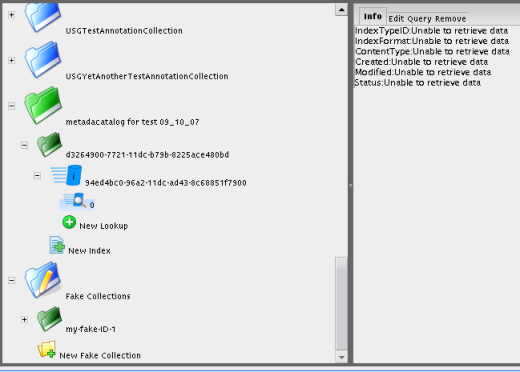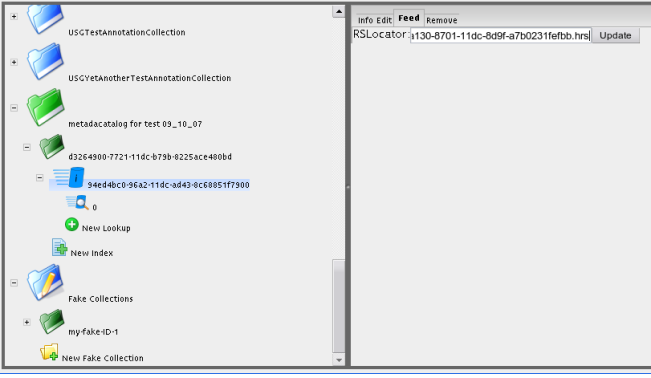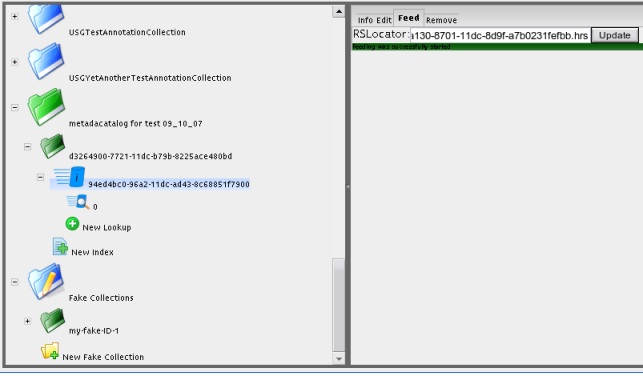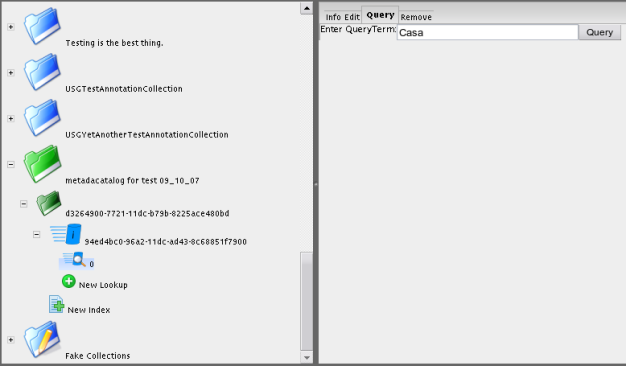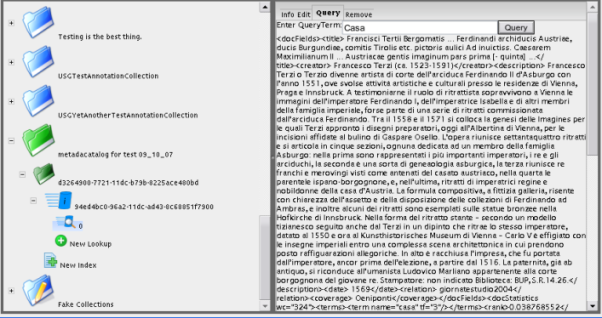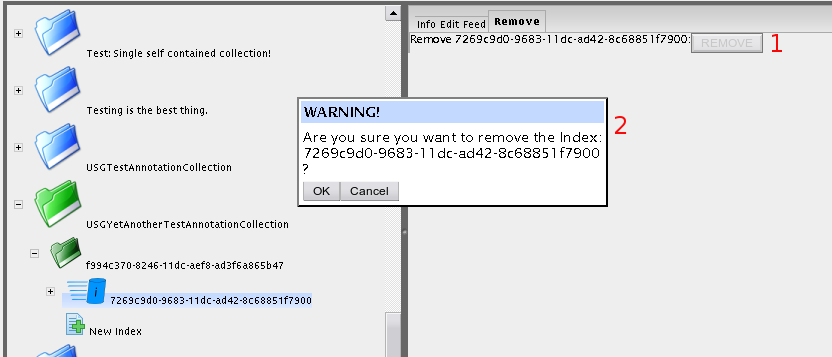Administration
Contents
VRE Monitoring
The Information System Monitoring user interface grants access to the all information handled by the Distributed Information System (DIS) from a Graphical User Interface. It queries and shows on demand the latest information published on a DIS instance, ranging from the profiles to the specific WS-Resource properties documents. By accessing to the Information System Monitoring user interface, it is possible to monitor the status of nay VRE deployed in the infrastructure.
On the left panel the user has the opportunity to choose which type of resource he wants to monitor.
On the upper-right panel the user can navigate the list of the resources of the type selected of the left panel.
The profile of the selected resource in the list is shown in the down right panel. By default the profile is shown in an user oriented view. Clicking on the button "XML View" the profile is shown in XML mode. Newly clicking on "Normal View" the profile is shown in an user oriented view.
Selecting "Map" on the left panel the location Map of the hardware resources are shown.
The green icons ![]() represent gLite Nodes, instead the yellow icons
represent gLite Nodes, instead the yellow icons ![]() represent DHN.
represent DHN.
Clicking on the icon a zoom is performed if needed and a Tabbed Information Window is open. Each tab represents a part of the information available for the selected node. In some cases in the Tab Information Window there are some links which cause the opening of a new browser window.
VRE Management
Resources Registration
It is possible to register various types of resource on infrastructure. There is a dedicated user interface for each of them. After the registration process, each resource is going on a pending state and needs to be approved by one administrator with the approval user interface.
External Running Instance Registration
An External Running Instance is a WEB-Service which we want to make available in the infrastructure.
Service Archive Registration
A Service Archive is a software component compliant with gCube policies we want to register in the infrastructure.
DHN Registration
A DHN is a Server empowered by the DHN software component.
Archive/Data source Registration
Any existing data sources can be made available in the infrastructure defining the appropriate configuration file. The syntax of the configuration file is described in the Archive Import service documentation.
Resources Approval
For each kind of resource the user can register, the approving step need to be performed by one administrator. After this step the resource are available on the infrastructure.
All this portlets are list with a checkbox on each row. After the selection process the administrator has the opportunity to choose the action he want to do. Two actions are possible: Approve or Withdraw. This is performed on the selected resources by clicking on the relative button. The list is paginated and present 10 resource for each page. The action has affect only on the selected resources on the current page.
External Running Instance Approval
Service Archive Approval
DHN Approval
Archive/Data source Approval
Services Deployment
This task is available with an user interface looks like the monitoring. Apart a reduced the monitoring issue the administrator can select the DHN and the Services he wants to deploy on the nodes. For the DHN only, the one in bold in the list can be selected. This due to configuration of the DHN made by the administrator, for example in respect of the institution policy or others reason. All Services can be selected.
The selection/deselection of one DHN or Service can be done using the button on the header of the bottom-right panel. When a Node or a Service is selected, it is inserted on the "Selected Resource Tree". These tree can be browsed as the "Available Resource Tree". These allow the user to have a sort of basket to check the selected resources in each moment.
Further, when a DHN is selected another entry is presented on the left panel. In particular it is present Running Instance On <Name of Selected DHN> entry. Clicking on it, the upper-right panel lists the already available Running Instance on that DHN. This allows the administrator to evaluate a DHN. For example, the administrator can decide if the selected DHN is the proper one to host new Service[s] deployment.
When at least one DHN and one Service are selected a Deploy button appears on the left panel.
Clicking on it the deploy process starts after a confirmation request.
During the deployment is presented a Dialog Box with the deployment status. The status is refreshed until the process is completed with a failure or with a success.
VRE Creation
Wizard mechanism is the way used to create a new VRE.
VRE Generator enables users/communities (VRE Designers) to define their own VREs and VRE Administrators to actually create them and monitor their operational status. It allows defining a set of criteria specifying the expected characteristics of the new VRE; starting from them, it identifies the set of resources required to provide the requested features.
The wizard is composed by 4 step at design time.
VRE Information
This step enables the VRE Designer to specify the name and the description the VRE will have. Moreover, it is possible to specify the users that play the role of VRE Designer (in addition to the user that is performing the design task) and the role of of VRE Administrator. Additional and optional information provided through this step is about the specificaction of VRE desired start- and end- time. If specified this last information will constrain the VRE operational time.
VRE Content
It will enable the VRE Designer to specify the characteristics of the VRE Content.
Two sub-steps are envisaged:
VRE Collections
The first sub-step allows to select the set of collections (Document Collections) constituting the VRE information space, i.e. the set of information objects that will be available into the VRE. For each collection, the portlet display the minimal set of information supporting the user in selecting the appropriate ones, namely name and description. This step will also provide a link with the Archive Importer portlet through which will be possible to add new Collections to the infrastructure.
VRE Metadata Format
The second sub-step allows to specify the set of metadata formats the previously selected collections will be available in, i.e. select the Metadata Collections describing the Document Collections accordingly to one or more metadata schema.
VRE Functionality
This step allows the VRE Designer to specify the set of Functions the VRE will be equipped with. By default the majority of the gCube Functions are mandatory, thus the portlet focuses on the selection of the optional functions.
VRE Architecture
When the Administrator will approve the VRE, he will be able to see and modify each step. Further, he will do an additional step VRE Architecture.
Index Management
Full Text Index
After opening the the FullTextManagementPortlet, you will see a screen with an Index Explorer tree on the left side, and an (empty) Index Detail panel on the right. The IndexDetail Panel will be emty as no index resource is currently selected in the Index Explorer tree. The Index Explorer panel however, will always display one or more folder icons when the portlet is ready for use:
The folder icons represent metadata collections available in the VO. A big green folder (marked with a [1] above) represents a collection name which has one or more related indices. A big blue folder (marked [2]) represents a collection name which does not have any related indices. The single blue folder with a pencil above it and the text "Fake Collections" (marked [3]) is the only icon which is certain to be shown (even if no collections exist). This icon represents all collection IDs which are related to one or more indices, but which can not be mapped to a true metadata collections. This is a usual scenario when test indices are created without the need to be connected to a collection, or with a specific need not to be connected to a collection in order to not be used by the rest of the DL infrastructure.
A collection name is not necessarily unique, as many collections are allowed to have the same name though not the same ID. Actual metadata collections are represented by a smaller folder icon, along with its collection ID. Collections which have been indexed, are represented by a green folder (marked [4]), while collections which have not been indexed are represented by a grey foler (marked [5]).
Full Text Index Information
If you expand the green collection tree items (by clicking on the [+] besides them), one or more Index icons (marked [1] bellow) will reveal them selves. These represent Index Managers. If any Index Lookups are connected to the Index Manager, the Index item can be expanded to reveal one or more Index Lookup icons (marked[2]):
If you select either an Index item or an Index Lookup item in the Index Explorer, the Index Detail panel will show a tab panel with information related to the selected resource (WS ResourceProperty values). If an Index item is choosen, the IndexDetail will look similar to the following illustration:
And if an Index Lookup item is chose, it will look similar to the following:
Editing the IndexType
In order to edit the Index Type of an Index Manager, make sure the correct Index item is selected in the Index Explorer, and select the "Edit" tab in the Index Detail tab panel. This will reveal Index Edit panel:
The chosen Index items IndexType is displayed as a list of Index Type Fields with editable checkboxes. The save button will save the IndexType currently shown to the selected Index Management resource.
If a Index Lookup item was selected, choosing the "Edit" tab will reveal the Index Lookup Edit panel:
This panel is identical to the Index Edit panel, however only the "Return" checkboxes are enabled. This is due to the fact that the Return Element is the only part of an IndexLookup's index type which is editable. Any other changes will have to be performed towards the Index Management (using the Index Edit panel)
Creating a Full Text Index
Creating a new Index can be accomplished by either selecting the "New Index" item (marked [1] bellow) or the "New Fake Collection" item (marked [2])in the Index Explorer:
Upon selecting one of the two said items, the Index Detail panel will allow you to specify the properties of the new Index. The IndexID property textbox should usually be left empty, in which case the IndexService itself will create a unique ID for the Index. If the "New Fake Collection" item was chosen, you will also need to specify a collection ID (fake - "myTestCollection1" or something to that effect), however if the "New Index" item was chosen, the collection ID will be retrieved from the parent collection item and will not be editable (as shown in the image above).
After specifying the properties of the new Index, push the "Create" button in order to create the new Index. Upon success, the new Index Item will appear and be selected in the Index Explorer. The "Info" tab of the new Index will be shown in the Index Detail panel:
Usually (and as shown in the above image), the Index Detail panel will be unable to retrieve information about the newly created Index. This is due to the fact that there is a slight lag between the creation of an Index and the availability of information about the Index. Selecting the newly created Index item once more (by clicking on it) will update the Index Detail panel with valid data.
Creating a Full Text Index Lookup
In order to query an Index, an Index Lookup resource is needed. An Index Lookup can be created at any point in the life time of an Index, and will automatically be updated when new information is indexed by its Index Manager. In order to create a new Index Lookup resource for an Index, select the "New Lookup" item under the Index item in the Index Explorer:
The Index Detail panel will show a very simple interface, allowing you to specify the Lemmatizer plugin the new Index Lookup should use. Usually, this text box should be left empty, in which case the default Lemmatizer plugin will be used. Pushing the "Create" button will trigger the creation of the new Index Lookup. Upon success, an item with a new icon will appear and be selected in the Index Explorer. This item represents the newly created Index Lookup. The "Info" tab of theIndex Lookup will be shown in the Index Detail panel:
As with the creation of an Index, the Index Detail will usually not be able to get information about the Index Lookup right after its creation, in which case you will have to select the Lookup item once more if you need to see valid information about the new item.
Feeding a Full Text Index
The information to be indexed is fed to the Index through a ResultSet. In order to index the ResultSet, select the Index item to use in the Index Explorer, and choose the "Feed" tab. Enter a valid RSLocator string in the textbox as shown bellow (the RSLocator string in the example is a bit strange since points to a local ResultSet):
Push the "Update" button to start the indexing of the provided ResultSet. A green label will indicate that the update has been successfully started:
Testing/Querying a Full Text Index
In order to test (by querying) an Index, an Index Lookup for the Index in question is needed. If one is not available, it has to be created. If an Index Lookup is available for the Index to be queried, select the Index Lookup in the Index Explorer and select the "Query" tab in the Index Detail panel. This tab allows you to enter a query string as shown bellow:
Pushing the Query button will perform a query against the Index Lookup. Upon success, the first page of the results of the query will be shown in its raw XML format bellow the query text box:
Removing a Full Text Index or Index Lookup
In order to remove an Index or an Index Lookup, select the item to be removed in the Index Explorer and choose the "Remove" tab in the Index Detail. Clicking the remove button (marked [1] bellow), will cause a warning dialog (marked [2]) to be shown. Push the "OK" button to remove the resource (and keep in mind that removing an Index resource will automatically remove all Index Lookup and Index Updater resources connected to it):
Upon success, a green confirmation message will be shown:
Upon failure, a red error message will be shown. This messge is usually due to the resource already having been removed, but still being present in the Index Explorer due to delays in the underlying infrastructure.
